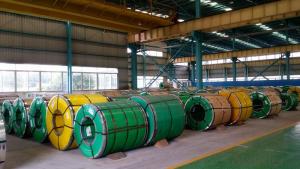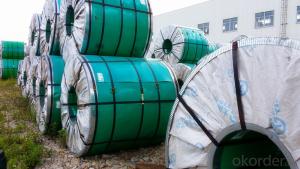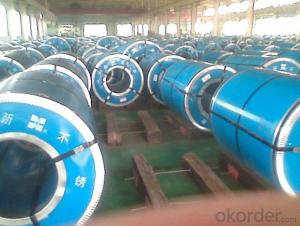Stainless Steel Coil 201 Surface No.1 Hot Rolled Coil
- Loading Port:
- Guangzhou
- Payment Terms:
- TT OR LC
- Min Order Qty:
- 100 m.t.
- Supply Capability:
- 5000 m.t./month
OKorder Service Pledge
OKorder Financial Service
You Might Also Like
Hot Rolled Stainless Steel Coil 201 Narrow Strip No.1 Finish
Hot Rolled Stainless Steel 201 half copper Chemical Composition(%) | |||||||
C | Si | Mn | P | S | Ni | Cr | Cu |
0.1 | 0.5 | 10 | 0.04 | 0.01 | 1.20/1.30 | 13.00/14.00 | 0.8/1.0 |
Grade: | 200 Series | Standard: | JIS,AISI,ASTM,GB,DIN | Thickness: | 2.5/3.0/4.0mm |
Width: | 485/510/550/610/1010/1240mm | Place of Origin: | Shanghai China (Mainland) | Brand Name: | CNBM |
Model Number: | 201 | Technique: | Hot Rolled | Application: | Industrial tubes/kitchen/bath |
Certification: | ISO | THK: | 2.5/3.0/4.0mm | Face: | No.1 |
Usage: | tubes/kitchen/bath | Origin: | CHINA | ||
Packaging Detail: For customer's requirement
Delivery Detail: 10-30days
201 Hot Rolled Stainless Steel Coil Specifications
THK:2.3/2.5/3.0/4.0mm
Width:485/510/550/610/1010/1240mm
Face:No.1
201 Hot rolled stainless steel Coil Application
Stainless steel is a production which not easy rust,acid resistance and corrosion resistance,so it is widely
used in light industry,heavy industry,daily necessities and the decoration industry. 201 hot rolled stainless steel coil, use to produce cold rolled stainless steel coil and stainless steel tube, pipe.
201 Hot Stainless Steel Coil Chemical Composition(WT%)
(C):≤0.15, (Si):≤0.75, (Mn):5.5~7.50, (Cr):16.0~18.0, (N):≤0.25, (Ni):3.50~5.50, (P):≤0.060, (S):≤0.030
201 Hot Rolled Stainless Steel Coil
Strength Of Extension:100,000 To 180,000 Psi;
Yield Strength:50,000 To 150,000 Psi
Elongation :55 To 60%;
Modulus Of Elasticity:29,000,000 Psi;
Density :.280lbs/Cubic Inch(7.93g/Cm3)
- Q:Can stainless steel strips be used in the chemical industry?
- Yes, stainless steel strips can be used in the chemical industry. Stainless steel is known for its excellent corrosion resistance, which makes it an ideal choice for use in environments where there are chemicals present. It can withstand exposure to various chemicals, acids, and alkalis, making it suitable for applications such as chemical storage tanks, pipes, valves, and fittings. Additionally, stainless steel strips are durable, easy to clean, and maintain their strength and integrity even in harsh chemical environments. Therefore, they are widely used in the chemical industry for their reliability and longevity.
- Q:Can stainless steel strips be formed into complex shapes?
- Complex shapes can indeed be formed from stainless steel strips. The versatility and ductility of stainless steel enable effortless shaping and manipulation. By employing techniques like bending, rolling, and stamping, intricate and complex forms can be achieved with these strips. Moreover, the remarkable strength and corrosion resistance of stainless steel make it perfect for applications demanding elaborate shapes, like architectural structures, automotive parts, and kitchen appliances.
- Q:Can stainless steel strips be used for precision instruments?
- Yes, stainless steel strips can be used for precision instruments. Stainless steel is known for its excellent corrosion resistance, durability, and high strength, making it suitable for a wide range of applications, including precision instruments. Stainless steel strips can be manufactured to precise dimensions, ensuring accuracy and consistency in the instruments' construction. Additionally, stainless steel strips offer good thermal conductivity and can withstand extreme temperatures, which is crucial for precision instruments that may be exposed to varying environmental conditions. Moreover, stainless steel is non-magnetic, making it ideal for instruments that require non-magnetic properties. Overall, stainless steel strips provide the necessary qualities required for precision instruments, making them a suitable choice in various industries such as medical, aerospace, and scientific research.
- Q:Can stainless steel strips be used for architectural balustrades?
- Yes, stainless steel strips can be used for architectural balustrades. Stainless steel is a popular material choice for balustrades in architectural applications due to its durability, strength, and aesthetic appeal. Stainless steel strips can be shaped, bent, and welded to create intricate and stylish balustrade designs. Additionally, stainless steel is resistant to corrosion, making it suitable for both indoor and outdoor use. The smooth and polished surface of stainless steel strips adds a modern and sleek look to architectural balustrades, making them a popular choice in contemporary designs.
- Q:Can stainless steel strips be used in automotive exhaust systems?
- Automotive exhaust systems can indeed utilize stainless steel strips. Due to their exceptional corrosion resistance and durability, stainless steel is widely favored for exhaust systems. Its ability to withstand extreme temperatures and harsh conditions makes it an excellent fit for the demanding environment of an exhaust system. Stainless steel strips, renowned for their strength and resistance to rust and corrosion, are frequently employed in the construction of exhaust pipes, mufflers, and other components. Furthermore, stainless steel strips are easily moldable, weldable, and shapeable, enabling them to cater to the precise needs of an exhaust system, thus rendering them an ideal option for automotive applications.
- Q:Can stainless steel strips be used in telecommunications equipment?
- Yes, stainless steel strips can be used in telecommunications equipment. Stainless steel's excellent strength, durability, and corrosion resistance make it suitable for various components and structures in telecommunications equipment, such as antenna mounts, connectors, enclosures, and cable trays. Additionally, stainless steel's electrical conductivity properties also make it suitable for certain applications in telecommunications equipment.
- Q:What is the composition of 111 stainless steel strips?
- The composition of 111 stainless steel strips typically refers to the specific alloy used to manufacture these strips. Stainless steel is an iron-based alloy that contains a minimum of 10.5% chromium. In addition to chromium, stainless steel may also contain other elements such as nickel, molybdenum, manganese, and carbon. The exact composition of 111 stainless steel strips can vary depending on the specific grade or specification. For example, a common grade is 304 stainless steel, which typically consists of 18% chromium and 8% nickel. Another commonly used grade is 316 stainless steel, which contains 16-18% chromium, 10-14% nickel, and 2-3% molybdenum. To determine the precise composition of 111 stainless steel strips, it would be necessary to refer to the specific grade or specification provided by the manufacturer or supplier.
- Q:What are the different surface patterns available for stainless steel strips?
- Stainless steel strips come in a variety of surface patterns, each with its own unique characteristics and aesthetics. Some commonly used patterns include the following: 1. The No. 1 finish is the most frequently used surface finish for stainless steel strips. It has a rough, dull, and non-reflective surface, typically achieved through hot rolling methods. 2. The No. 2B finish is obtained by subjecting the strip to a further cold rolling process after the No. 1 finish. It has a slightly smoother and brighter appearance compared to the No. 1 finish, with a moderate level of reflectivity. 3. The No. 3 finish, also known as a brushed finish, involves brushing the stainless steel strip with abrasive materials. This creates a distinct linear brushed pattern, giving the strip a textured and matte appearance. 4. The No. 4 finish is a highly popular surface pattern. It is achieved by polishing the strip with finer abrasives, resulting in a smoother and more reflective surface compared to the No. 3 finish. It has a satin-like appearance. 5. The No. 8 mirror finish is the highest level of polish achievable for stainless steel strips. It undergoes a series of polishing steps to achieve a reflective, mirror-like surface. It is often used in architectural applications and for decorative purposes. 6. Embossed patterns are another option for stainless steel strips. Various patterns, such as diamond, linen, or leather grain, can be embossed onto the strip by pressing it between embossing rollers. This results in textured surfaces with an appealing visual appearance. 7. Perforated patterns are created by punching holes into the stainless steel strip using specialized machinery. This allows for different hole patterns, shapes, and sizes, providing enhanced functionality and design possibilities. These diverse surface patterns for stainless steel strips offer versatility and cater to a range of applications, including architecture, automotive, household appliances, and decoration. The choice of surface pattern depends on the desired aesthetic appearance, functionality, and specific project requirements.
- Q:What are the differences between hot-rolled and cold-rolled 111 stainless steel strips?
- The production processes and resulting characteristics of hot-rolled and cold-rolled 111 stainless steel strips differ significantly. Hot-rolled strips are created by subjecting the stainless steel to high temperatures and passing it through rollers to achieve the desired thickness. This method produces a material that is more malleable and ductile, making shaping and forming easier. The resulting strips have a rougher surface finish and a scaled oxide layer, which can be eliminated through additional processing if desired. Additionally, they tend to have a larger grain structure, resulting in less precise and more variable dimensional tolerance. Conversely, cold-rolled strips undergo further processing after being hot-rolled. This involves passing them through a series of rollers at room temperature, resulting in a smoother surface finish and a more precise dimensional tolerance. These strips have a finer grain structure and a more uniform thickness, making them ideal for applications that require precision and consistency. In terms of mechanical properties, hot-rolled strips generally exhibit higher yield and tensile strengths compared to cold-rolled strips due to strain hardening during the hot-rolling process. However, cold-rolled strips have better surface quality and improved flatness due to additional processing steps. To summarize, hot-rolled stainless steel strips are more malleable with a rougher surface finish, while cold-rolled strips offer better dimensional precision, surface quality, and flatness. The choice between the two depends on specific application requirements, such as the need for shaping, precision, or surface aesthetics.
- Q:What are the common uses of stainless steel strips in the pharmaceutical industry?
- Stainless steel strips are widely used in the pharmaceutical industry due to their unique properties that make them suitable for various applications. Some common uses of stainless steel strips in the pharmaceutical industry include: 1. Packaging: Stainless steel strips are often used for packaging pharmaceutical products such as tablets, capsules, and powders. They provide a safe and hygienic barrier that protects the medication from external contaminants, moisture, and light. 2. Sterilization containers: Stainless steel strips are utilized in the fabrication of sterilization containers, which are essential for the sterilization process in pharmaceutical manufacturing. These containers ensure that medical instruments, equipment, and supplies are effectively sterilized and maintained in a sterile condition. 3. Mixing and blending equipment: Stainless steel strips are used in the construction of mixing and blending equipment, including containers, tanks, and vessels. These equipment are crucial for the preparation of pharmaceutical formulations, ensuring efficient and consistent mixing of ingredients. 4. Conveyor systems: Stainless steel strips are commonly used in the construction of conveyor systems, which are extensively employed in pharmaceutical manufacturing for the transportation of raw materials, intermediate products, and finished goods. The corrosion-resistant nature of stainless steel makes it ideal for this purpose, as it ensures the cleanliness and purity of the pharmaceutical products during the manufacturing process. 5. Cleanroom applications: Stainless steel strips are utilized in cleanrooms, which are critical in the pharmaceutical industry to maintain a controlled environment free from contaminants. Stainless steel strips are used for fabricating cleanroom furniture, equipment, and fixtures, ensuring a hygienic and durable solution that can withstand frequent cleaning and disinfection. 6. Equipment and machinery components: Stainless steel strips are employed in the manufacturing of various components for pharmaceutical equipment and machinery, such as pumps, valves, fittings, and connectors. The high strength, corrosion resistance, and ease of fabrication of stainless steel make it a preferred material in these applications. Overall, stainless steel strips play a vital role in the pharmaceutical industry by offering a range of benefits, including corrosion resistance, durability, cleanliness, and ease of maintenance. These properties make stainless steel strips an ideal choice for various applications, ensuring the safety, quality, and efficacy of pharmaceutical products.
1. Manufacturer Overview |
|
|---|---|
| Location | |
| Year Established | |
| Annual Output Value | |
| Main Markets | |
| Company Certifications | |
2. Manufacturer Certificates |
|
|---|---|
| a) Certification Name | |
| Range | |
| Reference | |
| Validity Period | |
3. Manufacturer Capability |
|
|---|---|
| a)Trade Capacity | |
| Nearest Port | |
| Export Percentage | |
| No.of Employees in Trade Department | |
| Language Spoken: | |
| b)Factory Information | |
| Factory Size: | |
| No. of Production Lines | |
| Contract Manufacturing | |
| Product Price Range | |
Send your message to us
Stainless Steel Coil 201 Surface No.1 Hot Rolled Coil
- Loading Port:
- Guangzhou
- Payment Terms:
- TT OR LC
- Min Order Qty:
- 100 m.t.
- Supply Capability:
- 5000 m.t./month
OKorder Service Pledge
OKorder Financial Service
Similar products
New products
Hot products
Hot Searches
Related keywords





























